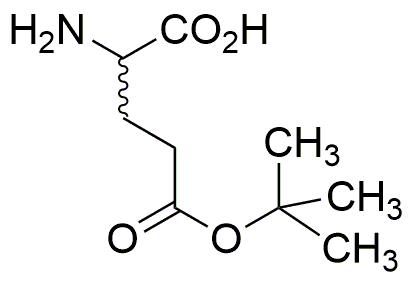DL-Glutamic acid g-tert-butyl ester is widely utilized in research focused on:
- Pharmaceutical Development: This compound serves as a key intermediate in the synthesis of various pharmaceuticals, particularly those targeting neurological disorders, enhancing drug efficacy and specificity.
- Biochemical Research: It is used in studies related to amino acid metabolism, helping researchers understand metabolic pathways and their implications in health and disease.
- Food Industry: The ester is employed as a flavor enhancer, contributing to the umami taste in food products, which is particularly valuable in developing savory snacks and seasonings.
- Cosmetic Formulations: Its properties make it a beneficial ingredient in skincare products, where it aids in moisture retention and skin barrier protection, appealing to consumers seeking effective personal care solutions.
- Polymer Chemistry: The compound is utilized in the production of biodegradable polymers, supporting the development of environmentally friendly materials that meet the growing demand for sustainable packaging solutions.
General Information
Properties
Safety and Regulations
Applications
DL-Glutamic acid g-tert-butyl ester is widely utilized in research focused on:
- Pharmaceutical Development: This compound serves as a key intermediate in the synthesis of various pharmaceuticals, particularly those targeting neurological disorders, enhancing drug efficacy and specificity.
- Biochemical Research: It is used in studies related to amino acid metabolism, helping researchers understand metabolic pathways and their implications in health and disease.
- Food Industry: The ester is employed as a flavor enhancer, contributing to the umami taste in food products, which is particularly valuable in developing savory snacks and seasonings.
- Cosmetic Formulations: Its properties make it a beneficial ingredient in skincare products, where it aids in moisture retention and skin barrier protection, appealing to consumers seeking effective personal care solutions.
- Polymer Chemistry: The compound is utilized in the production of biodegradable polymers, supporting the development of environmentally friendly materials that meet the growing demand for sustainable packaging solutions.
Documents
Safety Data Sheets (SDS)
The SDS provides comprehensive safety information on handling, storage, and disposal of the product.
Product Specification (PS)
The PS provides a comprehensive breakdown of the product’s properties, including chemical composition, physical state, purity, and storage requirements. It also details acceptable quality ranges and the product's intended applications.
Certificates of Analysis (COA)
Search for Certificates of Analysis (COA) by entering the products Lot Number. Lot and Batch Numbers can be found on a product’s label following the words ‘Lot’ or ‘Batch’.
*Catalog Number
*Lot Number
Certificates Of Origin (COO)
This COO confirms the country where the product was manufactured, and also details the materials and components used in it and whether it is derived from natural, synthetic, or other specific sources. This certificate may be required for customs, trade, and regulatory compliance.
*Catalog Number
*Lot Number
Safety Data Sheets (SDS)
The SDS provides comprehensive safety information on handling, storage, and disposal of the product.
DownloadProduct Specification (PS)
The PS provides a comprehensive breakdown of the product’s properties, including chemical composition, physical state, purity, and storage requirements. It also details acceptable quality ranges and the product's intended applications.
DownloadCertificates of Analysis (COA)
Search for Certificates of Analysis (COA) by entering the products Lot Number. Lot and Batch Numbers can be found on a product’s label following the words ‘Lot’ or ‘Batch’.
*Catalog Number
*Lot Number
Certificates Of Origin (COO)
This COO confirms the country where the product was manufactured, and also details the materials and components used in it and whether it is derived from natural, synthetic, or other specific sources. This certificate may be required for customs, trade, and regulatory compliance.


